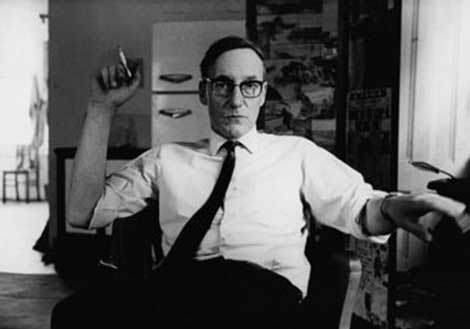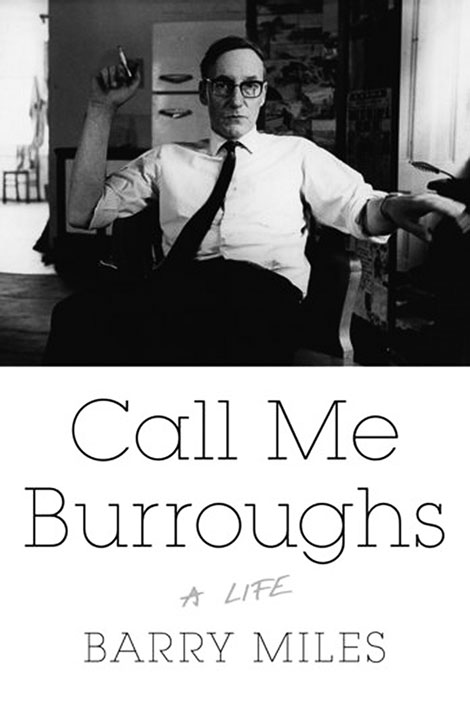A search of William Burroughs on Amazon turns up 3,976 items. If you add the word biography to your search, it narrows down to 135 items. Barry Miles wrote a biography of him in 1993, and released a revised version in 2002. He has also written books about Allen Ginsberg, Jack Kerouac, The Beat Hotel, Hippies, and 1970s counterculture. His latest tome, Call Me Burroughs came about when James Grauerholz (the keeper of William Burroughs Communications Inc.) found that his all-access pass to the Burroughs archives had yielded more information than he was able to shape into a book. Miles was a logical choice for this endeavor. Besides being a noteworthy author, he had prepared the Burroughs archive for sale and written a bibliography of Burroughs’ work. That sale tied up the Burroughs papers until 2010, so a good deal of new information was available since Miles had last written about him. Victor Bockris also offered up his unused research from his own book on Burroughs. Thus critical mass was achieved to initiate a really comprehensive biography to mark the centennial of his birth.
The book opens in a homemade sweat lodge in 1992. A Native American shaman has been brought to Lawrence, Kansas to exorcise something that Burroughs identified as “The Ugly Spirit” that had brought him so much trouble. Years of psychoanalysis caused him to believe that it was the result of an incident with his childhood “Nursy.” After the ceremony he declares himself free of the demon. He would live another five years.
Burroughs would probably have sputtered at the word American on his tombstone (he ultimately identified as a citizen of the world) but his story is uniquely American. His boyhood in St. Louis was a dystopia that might be visualized as Norman Rockwell by way of Banksy. His parents were upper middle class, but the nearby lake was actually an open sewer. He and his friends would gather under the sewer pipes to “watch the turds drop.” The smog was so bad that it was rotting the books in the library. His attitudes toward drug laws were formed early, when an uncle who had been buying legal morphine committed suicide after it was placed under regulation.
One of the big myths that this book puts to rest is that Burroughs lived on a trust fund from the adding machine company. That was an invention of Jack Kerouac. His parents managed to scrape together enough to send him $200-a-month allowance until his father died in 1964. He dabbled at jobs (exterminator, detective) but was loath to be considered part of the servant class. When he needed bail or lawyers or psychiatrists or somebody to raise his son, Mom and Dad were there. Many have speculated that this left him in a permanent state of adolescence.
He managed to actually get through Harvard, study Mayans as a postgraduate, and learn to fly a plane. His travels between the wars in Europe are some of the most compelling parts of the book. Anybody researching gay Europe of that period would do well to study the names and places mentioned herein. His ability with language almost caused him to study medicine in Vienna. He was avowedly apolitical until the night that Hitler had the gay SS elite murdered en masse. Before long he had enlisted to fly missions for the U.S. in WWII, but was left to read Proust in the barracks until his discharge for poor eyesight was processed.
Jack Black’s now legendary hobo memoir You Can’t Win caused a severe case of nostalgie la bou in Burroughs that eventually led to his heroin addiction. Much of the new material allows us a glimpse of the early days when everything was new and fun. There are colorful street characters and tales of attempts at crime. There are the chance encounters with famous homosexuals. It is as if the author was able to place a GPS unit on Burroughs and track him back through the years. This is no easy feat when the subject calls himself El Hombre Invisible and frequently changes addresses.
Everybody in the book gets their story unpacked and placed into the larger context. Along the way we learn that there were two wives (with their back stories generously accounted). The William Tell incident is told in greater depth. Most importantly we get to see Burroughs’ roots like we have never seen them before. It is both a definitive portrait of an artist and a fabulous slice of Americana.
CALL ME BURROUGHS: A Life
by Barry Miles
Illustrated. 718 pp. Twelve. $32





















0 Comments